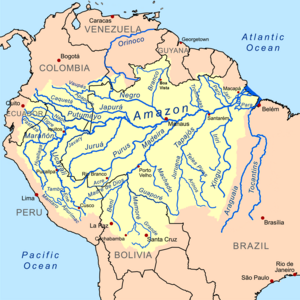Tigre River
| Tigre River | |
|---|---|
 | |
 Amazon Basin with Tigre River in the far west | |
| Location | |
| Country | Ecuador, Peru |
| Physical characteristics | |
| Source | confluence of Cunambo and Pintoyacu rivers |
| • elevation | 510 m (1,670 ft)[1] |
| Mouth | Marañón River |
• coordinates | 4°29′7″S 74°3′59″W / 4.48528°S 74.06639°W / -4.48528; -74.06639 |
• elevation | 95 m (312 ft)[1] |
| Length | 920.23 km (571.80 mi)[1] 760 km (470 mi)[2] |
| Basin size | 43,604.3 km2 (16,835.7 sq mi)[3] 45,073 km2 (17,403 sq mi)[4] |
| Discharge | |
| • location | Confluence of Marañón (near mouth) |
| • average | (Period: 1965–2013)3,046.77 m3/s (107,596 cu ft/s)[3] 3,279 m3/s (115,800 cu ft/s)[4] |
| Basin features | |
| Progression | Marañón → Amazon → Atlantic Ocean |
| River system | Amazon |
| Tributaries | |
| • left | Corrientes |
| • right | Tangarana |
The Tigre River (Spanish pronunciation: [ˈtiɣɾe]) is a Peruvian tributary of the Marañón River west of the Nanay River. It is navigable for 125 mi (201 km) from its confluence with the Marañón. It forms from the confluence of the Ecuadorian rivers Cunambo and Pintoyacu at the Peruvian border. Like the Nanay, it flows entirely on the plains. Its mouth is 42 mi (68 km) west of the junction of the Ucayali River with the Marañón. Continuing west from the Tigre along the Marañón River we have the Parinari, Chambira, and Nucuray, all short lowland streams, resembling the Nanay in character. Tigre is Spanish for "tiger" the vernacular name in the region for the Jaguar .
References
- ^ a b c Perú: Anuario de Estadistícas Ambientales 2022 (PDF). 2022.
- ^ Ziesler, R.; Ardizzone, G.D. (1979). "Amazon River System". The Inland waters of Latin America. Food and Agriculture Organization of the United Nations. ISBN 92-5-000780-9. Archived from the original on 8 November 2014.
- ^ a b "Evaluación de recursos hídricos en la cuenca Marañón". 2015.
- ^ a b "Oficina Nacional de Evaluación de Recursos Naturales (ONERN)". 1980.